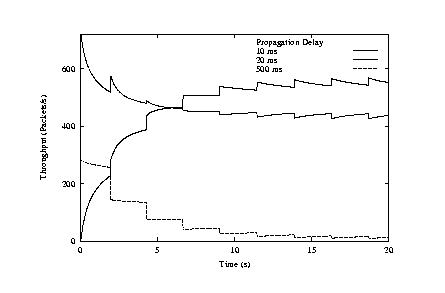C program
#include [stdio.h]
#include [math.h]#define MAX 2000
#define INC 0.01
#define PRECISION 20#define RENO 0
#define VEGAS 1#define ALPHA 1
#define GAMMA 0.5#define TCP1 0
#define TCP2 0
#define TCP3 0
#define TAU1 0.01
#define TAU2 0.02
#define TAU3 0.5
#define BUFFER 100
#define MU 1000float w1=0,w2=40,w3=150;
float t1,t2,t3;float buffer()
{float inf,sup,result,test;}
int i;
inf=0;
sup=BUFFER;
if (w1/TAU1+w2/TAU2+w3/TAU3 < MU) return(inf);
else
{
result=w1/(sup/MU+TAU1)+w2/(sup/MU+TAU2)+w3/(sup/MU+TAU3);
if (result < MU)
for (i=0;i < PRECISION;i++)
{
test=(inf+sup)/2;
result=w1/(test/MU+TAU1)+w2/(test/MU+TAU2)+w3/(test/MU+TAU3);
if (result < MU) sup=test;
else inf=test;
}
return(sup);
}window(float x)
{float rtt;}
rtt=TAU1+x/MU;
if ((TCP1)&&(w1*(1-TAU1/rtt) > ALPHA))
{
w1=w1-INC/rtt;
if (w1 < 0) w1=0;
}
else
w1=w1+INC/rtt;
rtt=TAU2+x/MU;
if ((TCP2)&&(w2*(1-TAU2/rtt) > ALPHA))
{
w2=w2-INC/rtt;
if (w2 < 0) w2=0;
}
else
w2=w2+INC/rtt;
rtt=TAU3+x/MU;
if ((TCP3)&&(w3*(1-TAU3/rtt) > ALPHA))
{
w3=w3-INC/rtt;
if (w3 < 0) w3=0;
}
else
w3=w3+INC/rtt;main()
{}
float x;
int i;
for (i=1;i < MAX;i++)
{
/* Buffer Occupation */
x=buffer();
while (x >= BUFFER)
{
w1=w1*GAMMA;
w2=w2*GAMMA;
w3=w3*GAMMA;
x=buffer();
}
/* Window Dynamics */
t1=w1/(TAU1+x/MU);
t2=w2/(TAU2+x/MU);
t3=w3/(TAU3+x/MU);
printf("%f %f %f %f %f %f %f\n",(float) i*INC,w1,w2,w3,t1,t2,t3);
window(x);
}

Example 1
Consider the case of 3 TCP Reno connections with propagation delays TAU1 =10 ms, TAU2 =20 ms, TAU3 =500 ms and starting from initial window sizes W1 = 0, W2 = 40 and W3 = 150.
The speed of the bottleneck is MU = 1000 packets/s and the buffer size B = 100 packets. The simulation results (see below) show that TCP Reno significantly discriminates against connections with large propagation delays.


Example 2
Consider the case of
